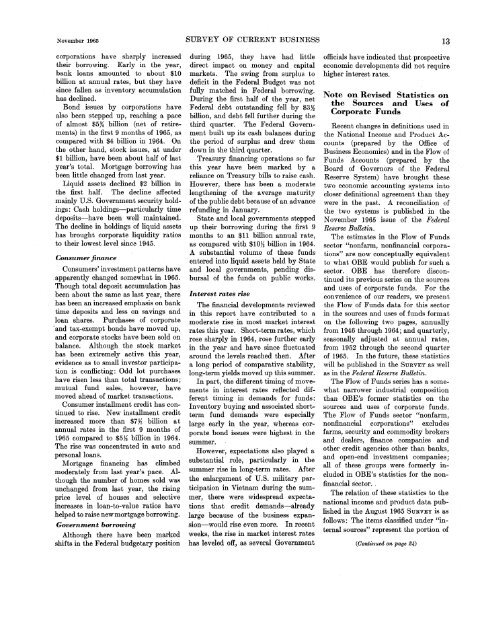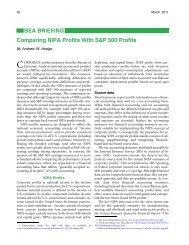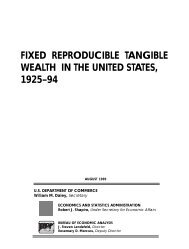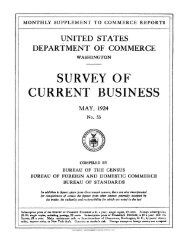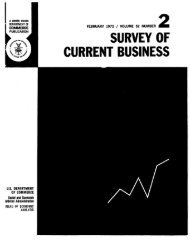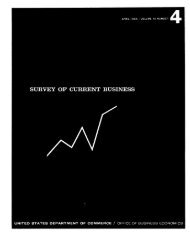the BUSINESS SITUATION - Bureau of Economic Analysis
the BUSINESS SITUATION - Bureau of Economic Analysis
the BUSINESS SITUATION - Bureau of Economic Analysis
Create successful ePaper yourself
Turn your PDF publications into a flip-book with our unique Google optimized e-Paper software.
November 1965 SURVEY OF CURRENT <strong>BUSINESS</strong> 13<br />
corporations have sharply increased<br />
<strong>the</strong>ir borrowing. Early in <strong>the</strong> year,<br />
bank loans amounted to about $10<br />
billion at annual rates, but <strong>the</strong>y have<br />
since fallen as inventory accumulation<br />
has declined.<br />
Bond issues by corporations have<br />
also been stepped up, reaching a pace<br />
<strong>of</strong> almost $5% billion (net <strong>of</strong> retirements)<br />
in <strong>the</strong> first 9 months <strong>of</strong> 1965, as<br />
compared with $4 billion in 1964. On<br />
<strong>the</strong> o<strong>the</strong>r hand, stock issues, at under<br />
$1 billion, have been about half <strong>of</strong> last<br />
year's total. Mortgage borrowing has<br />
been little changed from last year.<br />
Liquid assets declined $2 billion in<br />
<strong>the</strong> first half. The decline affected<br />
mainly U.S. Government security holdings:<br />
Cash holdings—particularly time<br />
deposits—have been well maintained.<br />
The decline in holdings <strong>of</strong> liquid assets<br />
has brought corporate liquidity ratios<br />
to <strong>the</strong>ir lowest level since 1945.<br />
Consumer finance<br />
Consumers' investment patterns have<br />
apparently changed somewhat in 1965.<br />
Though total deposit accumulation has<br />
been about <strong>the</strong> same as last year, <strong>the</strong>re<br />
has been an increased emphasis on bank<br />
time deposits and less on savings and<br />
loan shares. Purchases <strong>of</strong> corporate<br />
'and tax-exempt bonds have moved up,<br />
and corporate stocks have been sold on<br />
balance. Although <strong>the</strong> stock market<br />
has been extremely active this year,<br />
evidence as to small investor participation<br />
is conflicting: Odd lot purchases<br />
have risen less than total transactions;<br />
mutual fund sales, however, have<br />
moved ahead <strong>of</strong> market transactions.<br />
Consumer installment credit has continued<br />
to rise. New installment credit<br />
increased more than $7K billion at<br />
annual rates in <strong>the</strong> first 9 months <strong>of</strong><br />
1965 compared to $5% billion in 1964.<br />
The rise was concentrated in auto and<br />
personal loans.<br />
Mortgage financing has climbed<br />
moderately from last year's pace. Although<br />
<strong>the</strong> number <strong>of</strong> homes sold was<br />
unchanged from last year, <strong>the</strong> rising<br />
price level <strong>of</strong> houses and selective<br />
increases in loan-to-value ratios have<br />
helped to raise new mortgage borrowing.<br />
Government borrowing<br />
Although <strong>the</strong>re have been marked<br />
shifts in <strong>the</strong> Federal budgetary position<br />
during 1965, <strong>the</strong>y have had little<br />
direct impact on money and capital<br />
markets. The swing from surplus to<br />
deficit in <strong>the</strong> Federal Budget was not<br />
fully matched in Federal borrowing.<br />
During <strong>the</strong> first half <strong>of</strong> <strong>the</strong> year, net<br />
Federal debt outstanding fell by $3%<br />
billion, and debt fell fur<strong>the</strong>r during <strong>the</strong><br />
third quarter. The Federal Government<br />
built up its cash balances during<br />
<strong>the</strong> period <strong>of</strong> surplus and drew <strong>the</strong>m<br />
down in <strong>the</strong> third quarter.<br />
Treasury financing operations so far<br />
this year have been marked by a<br />
reliance on Treasury bills to raise cash.<br />
However, <strong>the</strong>re has been a moderate<br />
leng<strong>the</strong>ning <strong>of</strong> <strong>the</strong> average maturity<br />
<strong>of</strong> <strong>the</strong> public debt because <strong>of</strong> an advance<br />
refunding in January.<br />
State and local governments stepped<br />
up <strong>the</strong>ir borrowing during <strong>the</strong> first 9<br />
months to an $11 billion annual rate,<br />
as compared with $10K billion in 1964.<br />
A substantial volume <strong>of</strong> <strong>the</strong>se funds<br />
entered into liquid assets held by State<br />
and local governments, pending disbursal<br />
<strong>of</strong> <strong>the</strong> funds on public works.<br />
Interest rates rise<br />
The financial developments reviewed<br />
in this report have contributed to a<br />
moderate rise in most market interest<br />
rates this year. Short-term rates, which<br />
rose sharply in 1964, rose fur<strong>the</strong>r early<br />
in <strong>the</strong> year and have since fluctuated<br />
around <strong>the</strong> levels reached <strong>the</strong>n. After<br />
a long period <strong>of</strong> comparative stability,<br />
long-term yields moved up this summer.<br />
In part, <strong>the</strong> different timing <strong>of</strong> movements<br />
in interest rates reflected different<br />
timing in demands for funds:<br />
Inventory buying and associated shortterm<br />
fund demands were especially<br />
large early in <strong>the</strong> year, whereas corporate<br />
bond issues were highest in <strong>the</strong><br />
summer.<br />
However, expectations also played a<br />
substantial role, particularly in <strong>the</strong><br />
summer rise in long-term rates. After<br />
<strong>the</strong> enlargement <strong>of</strong> U.S. military participation<br />
in Vietnam during <strong>the</strong> summer,<br />
<strong>the</strong>re were widespread expectations<br />
that credit demands—already<br />
large because <strong>of</strong> <strong>the</strong> business expansion—would<br />
rise even more. In recent<br />
weeks, <strong>the</strong> rise in market interest rates<br />
has leveled <strong>of</strong>f, as several Government<br />
<strong>of</strong>ficials have indicated that prospective<br />
economic developments did not require<br />
higher interest rates.<br />
Note on Revised Statistics on<br />
<strong>the</strong> Sources and Uses <strong>of</strong><br />
Corporate Funds<br />
Recent changes in definitions used in<br />
<strong>the</strong> National Income and Product Accounts<br />
(prepared by <strong>the</strong> Office <strong>of</strong><br />
Business <strong>Economic</strong>s) and in <strong>the</strong> Flow <strong>of</strong><br />
Funds Accounts (prepared by <strong>the</strong><br />
Board <strong>of</strong> Governors <strong>of</strong> <strong>the</strong> Federal<br />
Reserve System) have brought <strong>the</strong>se<br />
two economic accounting systems into<br />
closer definitional agreement than <strong>the</strong>y<br />
were in <strong>the</strong> past. A reconciliation <strong>of</strong><br />
<strong>the</strong> two systems is published in <strong>the</strong><br />
November 1965 issue <strong>of</strong> <strong>the</strong> Federal<br />
Reserve Bulletin.<br />
The estimates in <strong>the</strong> Flow <strong>of</strong> Funds<br />
sector "nonfarm, nonfinancial corporations"<br />
are now conceptually equivalent<br />
to what OBE would publish for such a<br />
sector. OBE has <strong>the</strong>refore discontinued<br />
its previous series on <strong>the</strong> sources<br />
and uses <strong>of</strong> corporate funds. For <strong>the</strong><br />
convenience <strong>of</strong> our readers, we present<br />
<strong>the</strong> Flow <strong>of</strong> Funds data for this sector<br />
in <strong>the</strong> sources and uses <strong>of</strong> funds format<br />
on <strong>the</strong> following two pages, annually<br />
from 1946 through 1964; and quarterly,<br />
seasonally adjusted at annual rates,<br />
from 1952 through <strong>the</strong> second quarter<br />
<strong>of</strong> 1965. In <strong>the</strong> future, <strong>the</strong>se statistics<br />
will be published in <strong>the</strong> SURVEY as well<br />
as in <strong>the</strong> Federal Reserve Bulletin.<br />
The Flow <strong>of</strong> Funds series has a somewhat<br />
narrower industrial composition<br />
than OBE's former statistics on <strong>the</strong><br />
sources and uses <strong>of</strong> corporate funds.<br />
The Flow <strong>of</strong> Funds sector "nonfarm,<br />
nonfinancial corporations 7 - excludes<br />
farms, security and commodity brokers<br />
and dealers, finance companies and<br />
o<strong>the</strong>r credit agencies o<strong>the</strong>r than banks,<br />
and open-end investment companies;<br />
all <strong>of</strong> <strong>the</strong>se groups were formerly included<br />
in OBE's statistics for <strong>the</strong> nonfinancial<br />
sector. , . •<br />
The relation <strong>of</strong> <strong>the</strong>se statistics to <strong>the</strong><br />
national income and product data published<br />
in <strong>the</strong> August 1965 SURVEY is as<br />
follows: The items classified under "internal<br />
sources" represent <strong>the</strong> portion <strong>of</strong><br />
(Continued on page 24)


